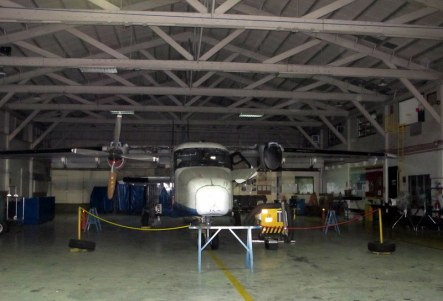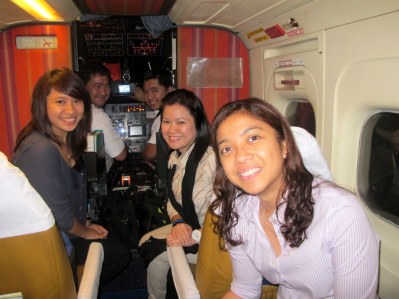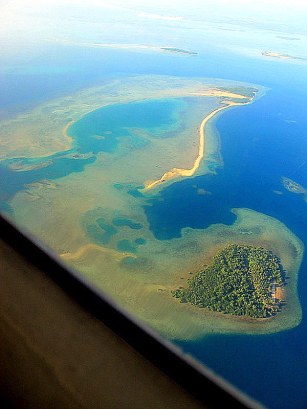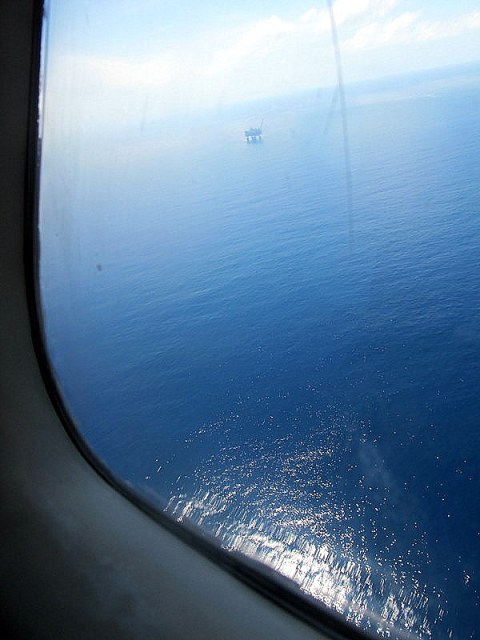 My fly-by experience to the trailblazing Malampaya Deep Water Gas-to-Power project’s offshore production platform
My fly-by experience to the trailblazing Malampaya Deep Water Gas-to-Power project’s offshore production platform
I’ve been part of the energy industry for close to half a decade now. This year, I’m performing a new role as part of the Upstream Industry, specifically involving the exploration and production of natural gas for electric power generation.
As part of getting introduced to my new job, I was invited to join a fly-by to our gas production platform offshore Palawan, one of the largest and most beautiful island provinces in the country. This was a rare opportunity as the Malampaya production platform is a no-fly zone for airplanes. However, the fly-by was organized as part of the activities in celebration of the Malampaya Deep Water Gas-to-Power Project’s 10th Anniversary (2001-2011) of powering the country with natural gas, the cleanest fossil fuel and also dubbed “the fuel of the future”, with its vast reserves under the ocean floor.
Pioneering project
The Malampaya Deep Water Gas-to-Power Project represents the largest and most significant industrial investment in the history of the Philippines, providing indigenous or locally-sourced and cleaner-burning natural gas for power generation, providing electricity to half of the homes, cities and industries in Luzon.
Malampaya heralded the birth of the natural gas industry in the Philippines, helping to lessen the country’s dependence on imported fuel. The discovery of an alternative source of energy was a milestone event for the country, which has historically imported fuel for its domestic and industrial power requirements.
The natural gas from Malampaya’s offshore production platform is transported via a 504-kilometer subsea pipeline to the onshore processing gas plant in Batangas, which then supplies three power stations – the 1,000-megawatt Sta. Rita power plant, the 500-megawatt San Lorenzo power plant, and the 1,200-megawatt Ilijan power plant – to generate a combined 2,700 megawatts of electric power for Luzon.
How it all began
The Malampaya project began with the discovery of a major gas field in 1992. It is the first deepwater commercial energy project in the Philippines. The natural gas field lies under some 3,000 meters of water.
The project’s daunting task was to ensure that some 2.7 trillion cubic feet of natural gas reserves and 85 million barrels of condensate from such an extremely deepwater field could be continuously extracted, processed and transported safely.

The Malampaya platform offshore Palawan, and its 504-kilometer subsea pipeline to the Batangas onshore gas plant
Long before drilling began, a full range of studies, surveys and engagements were done to identify the different social and environmental impacts to be expected from Malampaya. These were all considered and addressed in the project design. In laying the subsea pipeline, for example, the route was designed to avoid all active seismic fault lines, environmentally sensitive regions, fishing grounds and ancestral domains, as well as to have minimal disturbance to the sea bed.
Malampaya has been widely recognized for its high-impact sustainable development programs for communities near its operations.
Off to Palawan
From Manila, we took the early morning flight to Puerto Princesa city, Palawan’s capital. It was my first time to ride a chartered plane and it was quite an experience. Our light aircraft was a 19-seater, German-made, Dornier 228-212 airplane. The plane was not pressurized so we were asked to wear ear protectors. Despite this, we could still hear the loud roar of the plane’s engine and propellers. You will definitely not be able to carry a conservation throughout the two-hour flight so we made good use of our time by catching on sleep. Besides, it was still dark when we left Manila at 5:30am.

At the Island Transvoyager, Inc. (ITI) hangar in Pasay City. ITI engages in air taxi and air charter operations utilizing German-made Dornier 228-212 aircrafts. ITI is the only fixed wing operator accredited by both Shell and Exxon Mobil.

Ready to experience our first chartered flight from Manila to Puerto Princesa, Palawan. It was still dark when my colleague Chiqui and I boarded the plane for our 5:30am flight.

All aboard! Chiqui, Dina and I were the only passengers for the flight. Here we are with the ITI pilots.
It’s a good thing the weather was perfect for the trip and the flight was relatively smooth. On not so good days, we were told the ride can be quite bumpy and even terrifying. The flight attendant gave us candies before boarding the plane and behind the seats there were ready bags in case someone got plane sick from motion discomfort.

Left photo: Left photo: Chiqui ready to sleep on the flight with her ear muffs to drown out the noise of the Dornier's engine and propellers. Right photo: The mist inside the depressurized, light aircraft. Seems like we are passing through a thick cloud.
After falling sound asleep to the constant drone of the plane engine, I woke up to a breathtaking view outside my window. The horizon was refreshing as can be with the bright morning sunshine and below, I saw what I only used to see in postcards of Palawan waters. Different hues of blue water, peppered with small, lush green islets, and a trail of misty white sand bars. Beautiful. It was like waking up to a dream. I immediately took out my camera and started taking snapshots through my window. Of course, the photos do not do justice to the true beauty of the place.

Beautiful Palawan. This breathtaking view greeted me when I woke up from my slumber during the two-hour flight to gaze outside the plane's window. Palawan was rated by National Geographic Traveler magazine 2007 as the best island destination in East and Southeast Asia, having incredibly beautiful natural seascapes and landscapes.
Then our plane flew over the rolling hills and plateaus of Puerto Princesa. The island province’s forest cover is still very much in tact and I could not wait to get out of the plane and breathe in the clean air. I was told the province had zero carbon and I hope it stays that way!

Palawan has the largest forest cover in the Philippines, acting as a huge foam for carbon sequestration. The island province of Palawan maintains a zero-carbon emission level.
Malampaya up close
We arrived at Puerto Princesa airport to meet with the rest of the group that would join the fly-by. We were joined by local media, some local government officials and the very dedicated staff of our Malampaya Foundation, who implement our various sustainable development programs, such as capacity-building, health, environmental conservation and livelihood generation.

The 19-seater Dornier 228-212. The ITI pilots are trained in Germany to fly this German-made twin turboprop aircraft.

Left photo: Touchdown Puerto Princesa. Right photo: Warm welcome by the very dedicated Palawan-based staff of Malampaya Foundation, who implement various sustainable development programs for Palawan communities.
After having our weight recorded and listening to the safety briefing, we walked to the Dornier, the same plane we rode from Manila. This time, the Dornier would take us 80 kilometers offshore, northwest of Palawan, where the Malampaya Deep Water Gas-to-Power platform stands in a vast ocean of water.
This is the first airplane fly-by to the Malampaya production platform organized in the last 10 years since the project began its operations. I felt really lucky to get the chance to see the platform for real this time, after having written about it in our sustainable development reports and company magazine issues the past four years.
After about thirty minutes in flight, we were told that we were nearing the Malampaya platform. From my window I searched for a glimpse of it, and after looking at the big blue ocean, I spotted a grey object at the far end that definitely looks like Malampaya.

Spotted on the horizon -- the Malampaya gas production platform, a speck in the vast blue, endless ocean.
The pilots told us they would fly as close as possible to the platform so we could see it at eye level. The plane circled the platform twice on both sides, so those seated on the right and on the left of the plane had an equal chance of seeing it. Our media guests took lots of photos and video footage of the platform, that always seemed majestic in photographs I’ve seen before, but was now dwarfed by the enormity of the vast ocean surrounding it. I have all the more respect and admiration for our engineers who work at the platform, not only for withstanding the technical challenges of operating such a sophisticated facility but for braving the isolation and the exposure to the elements, away from civilization and practically in the middle of nowhere. Because of them, I am able to sit down comfortably and write this story through the electricity generated from Malampaya natural gas that powers my home, including the light and laptop I now use.

Closer, closer and closer to the majestic Malampaya offshore gas production platform! The airplane fly-by was done in commemoration of Malampaya's 10th anniversary.
Powering Philippine progress 10 years and beyond
The Malampaya Deep Water Gas-to-Power project is an outstanding example of Shell’s technology being used to develop and extract hard to reach gas in socially and environmentally responsible ways.
Cheers to 10 years of powering the nation and many more of powering progress with cleaner energy!
*With information from “Power from the Deep: The Malampaya Story” and the official website of Malampaya www.malampaya.com
+D.O.G.






